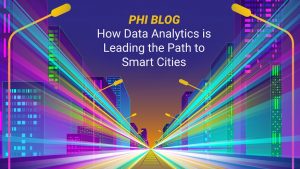As society becomes more technologically advanced, city leaders are leveraging data analytics to improve the quality of life for citizens.
A growing number of cities are investing in smart technology. The innovation is enabling municipalities to finally do something about mitigating the damage that modern living inflicts on the environment and the population.
Big data has the potential to benefit everyone – from captains of industry to housing insecure persons. Indeed, big data systems could lead to a better future.
Data, Data Everywhere
The proliferation of technology is so marked that the Bureau of Labor Statistics expects job openings for skilled professionals with the know-how to use data analytics tools to expand by 27% in 2026. The Internet of Things (IoT) is expanding rapidly across the urban landscape. As it does so, new opportunities are emerging that enable municipal leaders to understand hidden insights about how cities function. Simultaneously, more government agencies are embracing big data systems and sharing information across traditionally segregated organizations.
Because of these developments, big data systems have become an essential component of any smart city strategy. Predictive analytics, for instance, can help officials analyze traffic and public transportation patterns to improve the efficiency of conveyances. Also, agencies are increasingly leveraging up-to-date and real-time data to support public safety and social services.
Meanwhile, agencies that are responsible for energy efficiency are using big data systems to identify and take measures to support vulnerable households – through retrofitting programs, for instance. At the same time, the increasing use of open-source code is encouraging citizen engagement and developer creativity.
How Data Makes Cities Smart
Data analytics can potentially offer insights into nearly every aspect of public service and municipal activities. They already play a vital role in enabling cities, utility agencies and other municipal entities to optimize resources and move closer to zero-carbon objectives.
For example, some municipalities use analytics to manage community energy networks of distributed, renewable microgrids. One such initiative is the European Union’s Sharing Cities Program, which uses a sustainable energy management system (SEMS) to optimize energy production and distribution. The system also serves an additional source of insightful data for municipal leaders.
In transportation, agencies improve mobility by using real-time analytics collected from sensors and other devices to reduce travel time. The information also helps reduce the cost of operations and provide current information for transit users.
For instance, officials in Hangzhou, China use the Alibaba City Brain platform to forecast traffic patterns and detect accidents. Since deploying the technology, the city has dropped from the 5th worst congested city in the world to the 57th. Meanwhile, agencies that are responsible for communication are leveraging data analyses to make similar improvements across the vertical.
No One Left Behind?
A remarkable thing is taking place among municipalities that have embraced smart city technology. Typically, technological innovation serves the needs of those who have the money to pay for it. However, officials of some municipalities are using smart city technology to address the needs of the homeless population.
It’s hard to imagine high-tech driverless cars and beautiful, sustainable buildings bordering sidewalks filled with homeless people. Nevertheless, that’s what’s happening in some of the most advanced cities in the United States.
Officials now realize that traditional means of supporting the homeless population have failed. Historically, municipalities have managed the homeless population by operating shelters to keep homeless people off the street. Now, however, they want to get to the root of homelessness and are therefore looking for other alternatives to resolve the issue.
Municipal leaders hope to use big data systems to develop a holistic service-based system approach that offers a solution beyond temporary housing. For instance, the New York City’s Women in Need (WIN) shelters – in partnership with the NYU Center for Urban Science and Progress (CUSP) – are working toward providing Wi-Fi access for its temporary housing residents. WIN representatives express that since the organization houses 10% of the city’s homeless population, the service can generate substantial data that can help to provide insight into the housing insecure population.
The ways that officials have come up with to leverage big data systems for addressing homelessness are indeed remarkable. However, only time will tell if municipal leaders finally live up to their promise of finding an effective long-term solution for the problem.
The most significant barrier to making use of big data systems in any field is a lack of talent skilled in working with the technology. This circumstance is especially prevalent in the public sector. Once organizations figure out how to fill the talent gap, data sources that are embedded and much of cities’ infrastructure will provide municipal leaders with a wealth of information to help improve the quality of life in communities across America.
Source Credit: Ryan Ayers CEO, Ryan Ayers Communications
Whenever a data analysis technique is required, the simple book on the subject is Data Analysis Using Statistics and Probability with R Language by Bishnu and Bhattacherjee It is a complete introduction to data analysis and provides a sound understanding of the foundations of the data analysis.
For print book or an e-book, you may visit www.phindia.com
